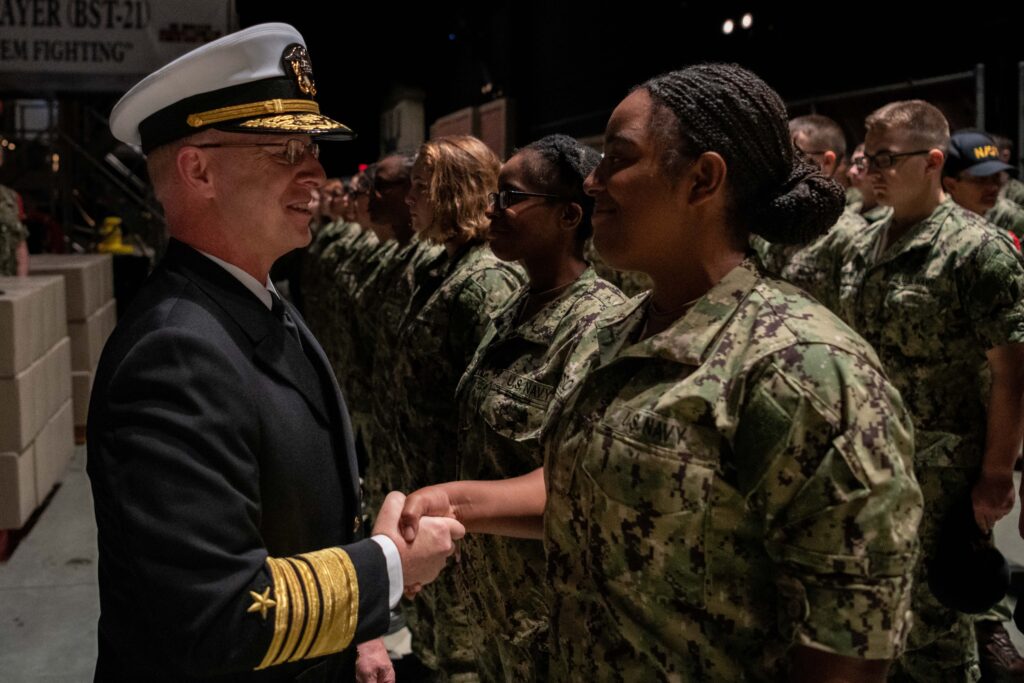
ARLINGTON, Virginia — The U.S. Navy must improve its workforce training, maintenance and surge capability to meet peer adversaries such as Russia and China, and is taking new steps to accomplish that goal, said Adm. Daryl Caudle, commander of U.S. Fleet Forces Command.
Speaking at the Surface Navy Association’s 36th National Symposium, Caudle said today’s joint force was shaped by a two-decade land war following a sustained peace after the end of the Cold War, and military leaders are now trying to “get the rudder over” to a multi-domain, high-speed, long-range warfare against potential enemies such as Russia and China, or both together.
“When we need to turn the volume up quickly on delivering combat power, the hardest spigot I own is and will always be inextricably related to building and developing human capital — our most precious resource — our warriors,” he said.
Caudle said he is focusing on Contingency Response Forces, those required to be ready to flow for combat within 30 days. “This is where I am applying my efforts. Readiness cannot be left at the pier, delayed in the shipyard, or undelivered on a production line. Further, it can’t be driven by empty recruiting stations or empty repair lockers.”
The Navy’s current Optimized Fleet Response Plan, or OFRP, “was not built to generate combat ready ships and air wings to meet the demand signal against peer adversaries,” Caudle said. “During peacetime force generation, the OFRP provides a steady supply of ready naval forces for a wide range of global presence operations. But it is not optimized to shift into high gear and generate, deploy, and regenerate a large surge of combat ready maritime forces.”
To help with that surge, Caudle’s office is developing the Global Maritime Response Plan, intended to give the chief of naval operations “a way to shift the Navy from peacetime to wartime” by bolstering some key organizations within the service, combining others and devolving or shutting down lower-priority commands and functions. It will also include having shell contracts in place, ready to fill out and execute.
“The Global Maritime Response Plan development is well under way,” Caudle said. “We are currently building out the Decision Support Matrices and the Response Conditions, or RESCONs, [think like DEFCON] that will be used to control how our Navy will be put on the required warfighting footing level to best support operational commanders.”
In some cases, he said, the effort simply involves compiling and codifying plans already in place at Navy organizations.
Working with Industry
The defense industry has gained traction in getting armaments and supplies to the fleet, Caudle said, one year after chastising the industry for falling behind in meeting defense needs.
“Despite the significant challenges we face with long-lead time parts, shipyard delays, less than optimal living conditions during maintenance periods, and personnel shortages across many rates and NECs, you all are just crushing it,” Caudle told SNA attendees. At last year’s event, he delivered a blunt warning to industry that he wouldn’t tolerate ordnance delays blamed on COVID or supply chain issues.
“To be honest, after I spoke at SNA last year, I wasn’t so sure how my remarks would be received, and even more important, acted on by the defense industrial base,” he said. “After voicing my displeasure about our inability to produce and deliver ordnance on time and in sufficient quantity, complete maintenance availabilities with modernizations efforts on time and on cost, and the need to be at flank speed to improve productivity, efficiency and build rates from our public and private shipyards to deliver new construction and overhauled ships to our fleet … instead of an adverse reaction, I think it really struck a chord with industry leaders, leaders within the Department of Defense, and with many congressional members who see the problems I identified in the same way.”
Caudle said he has been impressed with how many industry partners have reached out to his office and Navy program managers to step up production “through improvements using a ‘Get Real, Get Better’ approach in which we embrace the red together, self-assess together, and correct identified challenges together. Truly assessing weak areas and shifting rudder hard over and revving the gas to get back on PIM [plan of intended movement].”
In a separate interview with media, Caudle said after last year’s speech he worked with Vice Adm. Francis Morley, the principal military deputy assistant secretary of the Navy (research, development and acquisition) to bring in industry leaders that build munitions such as the Standard Missile and anti-ship missiles to “actually hear their perspective on places where we as the government could help them.”
Some solutions include multi-year contracts, how the Navy works with industry on quality control tests and test equipment improvements that need to be done.
“I probably overstated some things and got educated on some things, and I think they understood that we need these weapons, and their motivation to do that at pace was illustrated to me in spades,” he said.
In his remarks this year, Caudle cautioned that “while we have made some gains since my remarks last year at SNA, I would argue that we have not achieved the level of readiness, production, and deliveries required in both capabilities and capacity to claim we are ‘up on plane’ with a winning trajectory. Make no mistake about it — we face formidable threats on the horizon. And, while the nature of war never truly changes, these threats are fundamentally changing the character of how we prepare our Navy to fight.”






